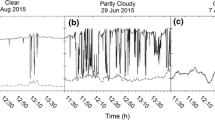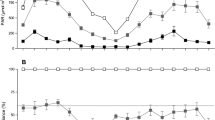Abstract
The seasonal variation in maximum photochemical efficiency of photosystem II (Fv/Fm) and the relationship between Fv/Fm and climatic factors such as irradiance, frost-nights and daily mean temperature was studied in young Norway spruce trees for 4 years in northern Sweden. As a result of night frost, the Fv/Fm-ratio gradually decreased during the autumn. There was between-year variation in the pattern of Fv/Fm in fully exposed shoots during autumn and spring, largely as an effect of differing temperature conditions. During spring, there was a strong apparent relationship between daily mean temperature and Fv/Fm within the temperature range –3 to 12°C. The light regime to which the needles were exposed during winter affected Fv/Fm, and moderately shaded shoots from the bottom of the canopy generally had a higher Fv/Fm-ratio than fully exposed shoots from the top of the canopy.
Similar content being viewed by others
Author information
Authors and Affiliations
Additional information
Received: 1 October 1997 / Accepted: 16 June 1998
Rights and permissions
About this article
Cite this article
Lundmark, T., Bergh, J., Strand, M. et al. Seasonal variation of maximum photochemical efficiency in boreal Norway spruce stands. Trees 13, 63–67 (1998). https://doi.org/10.1007/s004680050187
Issue Date:
DOI: https://doi.org/10.1007/s004680050187




